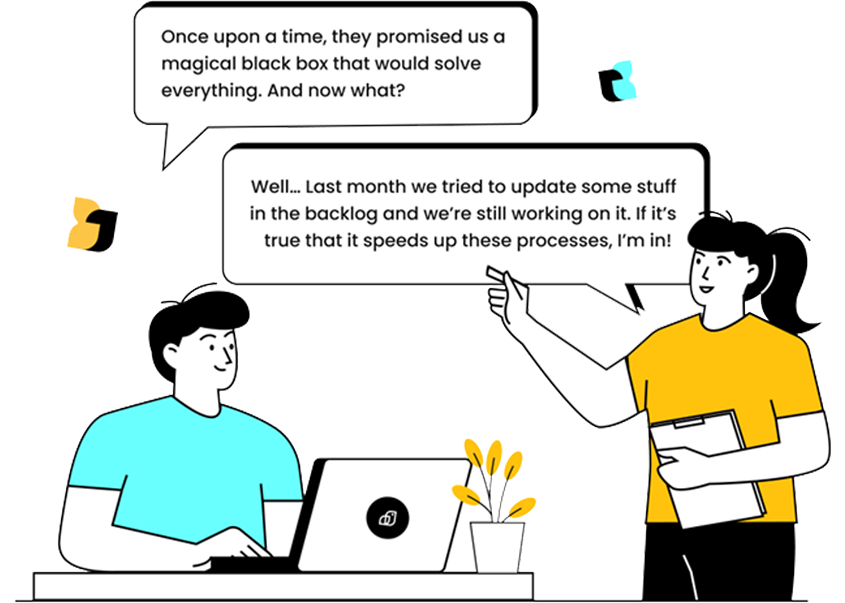
That spaghetti code you built on a rock-solid foundation, the one that’s been chugging along for years, faithfully doing its job...
Remember when you thought it wasuntouchable? Yeah, that one. Well, out of nowhere, that same system is beingcalled outdated by the very same people who once sold it to you. Andthey’re asking you to trust them again? Why should you?

Maybe back then, it was the best option we had. But things have changed. The future is bright and it looks a whole lot brighter with componentized, flexible architectures built in modern OSS solutions that can actually adapt to your needs.
And… guess what? Your back office called and it’s not okay. The integration failed, the alert got trapped in some dusty legacy queue, and now it’s ghosting you while swiping right on other options.
Visit our case studies for more information: Case studies
It’s Monday morning. You stroll into the office, coffee in hand, quietly manifesting a calm start to the week: Just a couple of meetings, no fires to put out, maybe even a chance to read all your emails before things start moving. And then…
Suddenly, your calm Monday morning feels like a tornado of alerts, meetings, and panicked Teams or Slack messages. Chaos and survival mode are now activated.
It’s Wednesday afternoon, and you’ve just settled into the rhythm of the week. Your dashboard lights up with red flags, and you realize: A new client order was supposed to go live yesterday… but it didn’t.
What should have been a simple, smooth activation has turned into a midweek nightmare. Teams are scrambling, clients are unhappy, and everyone is wondering why a supposedly “reliable” system keeps failing them.
It’s Friday, 3:00 PM. You’re just about ready to log off. Visions of the weekend; hiking, Netflix, or just sweet, sweet nothing… are dancing in your head. And then… ‘ding ding’.
You try to push it off until Monday, but your back office has other plans. It’s like a surprise fire drill that no one told you about, and the sprinklers are already going off.
If your back office was a person, it would be asking for therapy and a sabbatical.
These three scenarios aren’t just picked at random. We know they exist because we’ve seen it with our clients. And they’re symptoms of the same critical problem: legacy systems, outdated workflows, and brittle integrations that hold your OSS solutions back.
Now, look closely: Integration failures disrupt and slow down critical business processes, activation issues leave clients without their services and overload your customer care teams; and those last-minute alerts and compliance risks ruin your end of the week and keep teams in constant surviving mode.
Because, even when things aren’t breaking, legacy systems slow you down. It’s messy. It’s stressful. And it doesn’t matter how skilled your team is: errors are bound to happen.
Now imagine replacing that old machine with a new, modular OSS solution that offers multiple streams working independently, alerts that actually reach your inbox, automation, integrations that actually work, dashboards that give real-time insights, and teams that know what they are doing and care for you and your future.
Ready to see where your systems are struggling? Our Health Checker is a quick, honest form that helps you pinpoint what’s slowing your back office down.
How it works:
✅ You check off the issues that feel a little too familiar.
✅ We actually read it (humans, not bots).
✅ Then we reach out, with real thoughts, not templates, to talk about what makes the most sense for your goals and your tech stack.

Modular OSS solutions give you more than just flexibility and stability; they give you options:
Not convinced? Forward it to your CTO and say, “This hit a nerve, right?” 😬
Let’s move on from the legacy drama and fix what won’t serve your future aspirations. Because your back office deserves a little therapy—and so do you.

----------------------------------------------------------------------------------------------
1. What makes modern OSS solutions better than legacy systems?
Modern OSS solutions are modular, flexible, and integrate seamlessly, reducing errors and improving speed, reliability, and customer experience.
2. How can OSS solutions prevent activation and integration failures?
By centralizing workflows, automating processes, and providing real-time visibility, OSS solutions ensure orders and services flow smoothly across systems.
3. Why should telecom operators invest in modular OSS solutions?
Modular OSS solutions adapt to evolving business needs, support digital transformation, and reduce operational risks caused by fragmented legacy systems.